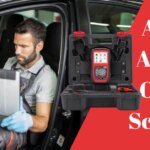A car starter, also known as a starter motor or simply a starter, is a crucial component of a vehicle’s internal combustion engine system. Its primary function is to initiate the engine’s operation by turning over the engine and enabling the combustion process that powers the vehicle.
Have ever you thought of how that turn of the key brings your car to life? How to spot bad starter on car symptoms?
Get ready for a starter system deep dive! From engine-cranking magic to quirky tapping tricks, we’ve got you covered.
Discover the role of a car starter, learn to spot trouble signs, and find out if you can jump-start your way to victory.
Unravel mysteries, save your ride – keep reading for all the starter secrets you’ve been itching to know!”
Table of Contents
What is a Car Starter?
A car starter is an electric motor designed specifically for the purpose of cranking or turning over the engine when the vehicle’s ignition key is turned to the “start” position. It generates the necessary rotational force to engage the engine’s flywheel or flexplate, which in turn initiates the internal combustion process. Once the engine starts running, the starter disengages automatically.
How Does a Car Starter Work?
The car starter works in conjunction with several other components in the vehicle’s starting system to ensure smooth engine initiation. Here’s how the car starter system operates:
- Key Turn: When the driver turns the ignition key to the “start” position, an electrical signal is sent to the starter solenoid.
- Solenoid Activation: The starter solenoid, a small electromagnetic switch, receives the electrical signal and becomes magnetized. This magnetism causes a plunger inside the solenoid to move, which, in turn, closes a heavy-duty electrical contact within the solenoid.
- Electrical Current Flow: With the solenoid contact closed, a large electrical current flows from the vehicle’s battery through the starter motor windings. This current generates a powerful electromagnetic field within the starter motor.
- Armature Rotation: The electromagnetic field exerts force on the starter motor’s armature (a cylindrical core with wire windings), causing it to rotate rapidly.
- Pinion Engagement: As the armature rotates, it turns the starter’s pinion gear. The pinion gear meshes with the teeth on the engine’s flywheel or flexplate, which is connected to the crankshaft. This engagement allows the starter’s rotation to transfer to the engine.
- Engine Cranking: The rotation of the starter motor’s armature and the engagement of the pinion gear cause the engine’s crankshaft to turn. This initiates the engine’s compression and combustion process, leading to the engine starting.
- Solenoid Release: Once the engine starts and reaches a certain speed, a built-in mechanism within the starter solenoid disengages the heavy-duty contact. This action interrupts the flow of current to the starter motor, causing it to stop rotating.
- Return to Rest Position: With the engine running, the pinion gear disengages from the flywheel or flexplate, and the starter motor returns to its rest position.
In modern vehicles, the process is often seamless and occurs within a matter of seconds. If the engine does not start or encounters difficulty, it could be due to issues with the starter system, battery, ignition system, or other related components.
Common Bad Starter on Car Symptoms
Engine Cranking But Not Starting
If you turn the key to the “start” position and hear the engine cranking (the starter motor is working), but the engine doesn’t actually start running, it could indicate a problem with the ignition system, fuel delivery, or other engine-related issues. However, if the starter motor is cranking consistently but the engine isn’t starting, the starter itself is likely not the problem.
Clicking Sound When Turning the Key
One of the most recognizable signs of a failing starter is a rapid clicking sound when you turn the key to start the engine. This typically happens when the starter solenoid is receiving power but is unable to engage the starter motor. The repeated clicking is often a result of insufficient current flow to the starter motor.
Frequent Need for Jump-Starting
If your vehicle frequently requires jump-starts to get going, it could be due to a failing starter or a weak battery. While jump-starting can temporarily get the engine running, it won’t address the underlying issue with the starter or battery. It’s important to have the system diagnosed and repaired to prevent future starting problems.
Dimming Headlights When Starting
When you attempt to start the engine and notice that the headlights or interior lights dim significantly or flicker, it suggests that the starter is drawing a large amount of current from the battery. This can be a sign of a starter motor that is struggling to turn the engine over, potentially due to wear or electrical problems.
Grinding Noise During Startup
If you hear a grinding noise while attempting to start the engine, it could indicate that the starter motor’s pinion gear is not properly engaging with the flywheel or flexplate. This can lead to damaged teeth on both the pinion gear and the flywheel, requiring prompt attention to avoid more extensive damage.
While these signs are commonly associated with a bad starter, they can also be indicative of other issues within the vehicle’s electrical and starting systems.
Diagnosing the Issue
Diagnosing starter system issues involves a systematic approach to pinpoint the root cause of the problem. Here’s how you can perform each of the mentioned diagnostic steps:
Testing the Battery Voltage
- Use a multimeter to measure the voltage of the vehicle’s battery. A healthy battery should read around 12.6 volts when fully charged.
- If the voltage is significantly lower, the battery might be weak or discharged, which can affect the starter’s performance.
- Charge the battery if needed and retest. If the voltage remains low, you may need to replace the battery.
Checking for Corroded Wires
- Inspect the battery terminals and cables for corrosion, rust, or loose connections.
- Corroded or loose connections can lead to poor electrical contact and reduced current flow, affecting the starter’s operation.
- Clean the terminals and cables if corroded, ensuring a good metal-to-metal connection.
Using a Voltage Drop Test
- Perform a voltage drop test to identify any excessive resistance in the starter circuit.
- Connect the positive lead of the multimeter to the positive terminal of the battery and the negative lead to the starter motor’s terminal.
- Have an assistant turn the ignition key to the “start” position while you monitor the multimeter reading.
- A significant voltage drop (usually more than 0.5 volts) indicates high resistance in the circuit, potentially caused by corroded wires or poor connections.
- Check and clean any connections or wires contributing to the voltage drop.
Inspecting the Solenoid
- The solenoid plays a crucial role in engaging the starter motor. If it’s faulty, the starter won’t function properly.
- Listen for a clicking sound when turning the ignition key. If you hear a click but the starter doesn’t engage, it could indicate a problem with the solenoid.
- Perform a visual inspection of the solenoid for any signs of damage or wear.
- Use a multimeter to test the solenoid’s continuity. Check the service manual for your vehicle to find the correct terminals to test.
- If the solenoid is not functioning properly, it may need to be replaced.
Diagnosing and repairing starter system issues can sometimes be complex, and it’s important to have the necessary tools and knowledge. If you’re not comfortable performing these tests yourself, it’s recommended to seek assistance from a qualified mechanic. They have the expertise to accurately diagnose the problem and carry out the appropriate repairs to ensure your vehicle’s starting system functions reliably.
Bad Starter vs Other Culprits
Differentiating Between Battery and Starter Problems:
Symptoms of Battery Issues:
- Dim lights or electrical components, even when the engine is not running.
- Inability to start the engine, with no cranking sound or attempt from the starter.
- Rapid clicking sound when trying to start the engine (often indicative of insufficient power to engage the starter).
Symptoms of Starter Problems:
- Audible cranking sound when attempting to start, but the engine does not start or turns over very slowly.
- A grinding noise during startup (indicating problems with the starter gear engagement).
- No response from the starter when turning the key (no clicking).
Distinguishing Between Starter and Alternator Issues:
Symptoms of Starter Issues:
- Engine cranks slowly or not at all when trying to start.
- Grinding noise during startup.
- Clicking sound when turning the key.
Symptoms of Alternator Issues:
- Dimming headlights or interior lights while driving.
- Battery warning light on the dashboard.
- Electrical components malfunctioning or not working.
Key Points for Differentiation
- Starter issues primarily manifest when attempting to start the engine. If the engine doesn’t crank or cranks slowly, suspect the starter or related components.
- Battery issues are often indicated by dimming lights, no response from the starter, and frequent need for jump-starts.
- Alternator issues are more apparent while driving, with dimming lights and electrical component problems. A failing alternator can also lead to a drained battery if left unaddressed.
DIY Starter Troubleshooting Steps
Tapping the Starter as a Temporary Fix
- Sometimes, the starter solenoid or contacts can become stuck. Lightly tapping the starter motor with a rubber mallet or a similar tool while someone tries to start the engine might free up the stuck components and allow the engine to start.
- This is a temporary solution and should only be used to get the vehicle running long enough to reach a repair shop.
Cleaning or Replacing Corroded Wires
- Check the battery terminals and cables for corrosion or rust. Corroded connections can impede the flow of electricity.
- Disconnect the battery terminals and use a wire brush or sandpaper to clean the terminals and cable ends.
- If the corrosion is severe or the cables are damaged, consider replacing them.
Testing and Recharging the Battery
- Use a multimeter to measure the battery voltage. A fully charged battery should read around 12.6 volts.
- If the voltage is low, charge the battery using a battery charger. Ensure the battery is holding a charge before proceeding.
- Reattempt starting the vehicle. A weak battery can cause starting issues even if the starter is functioning properly.
Reconnecting Loose Wires
- Inspect the wires connected to the starter motor and solenoid. Ensure all connections are tight and secure.
- If you find any loose wires, reattach them firmly.
Checking the Ignition Switch and Neutral Safety Switch (Automatic Transmission)
- In some cases, the ignition switch or the neutral safety switch (if you have an automatic transmission) could be faulty.
- Test the ignition switch by turning the key to the “start” position and checking for continuity in the switch’s electrical contacts.
- Test the neutral safety switch by trying to start the vehicle in neutral instead of park (if applicable).
Replacing the Starter Motor
- If the above steps do not resolve the issue, and you have determined that the starter is the likely culprit, you may need to replace it.
- Ensure you have the necessary tools and replacement starter motor.
- Refer to your vehicle’s repair manual for specific instructions on removing and installing the starter motor. This can vary widely between vehicle makes and models.
Find your compatible Car Starter Replacement HERE
When to Seek Professional Help
Importance of Professional Diagnosis
- If you’ve attempted basic troubleshooting steps and the issue persists, it’s time to seek professional help.
- A qualified mechanic has the expertise, tools, and diagnostic equipment to accurately identify the root cause of the problem and provide proper solutions.
Risks of Ignoring Starter Problems
- Ignoring starter problems can lead to more severe issues over time.
- A failing starter can leave you stranded unexpectedly, leading to inconvenience and potential safety risks.
Preventive Measures for Starter Health
Regular Battery Maintenance
- A healthy battery is essential for proper starter function. Keep the battery terminals clean and free of corrosion.
- Monitor the battery’s voltage regularly and charge it when necessary to avoid strain on the starter.
Avoiding Overuse of Accessories
- Excessive use of electrical accessories (lights, radio, air conditioning, etc.) while the engine is off can drain the battery and impact starter performance.
- Limit the use of accessories when the engine is not running to preserve battery power.
Proper Shutdown Procedures
- Before turning off the engine, ensure all electrical accessories are turned off. This prevents a sudden surge in power demand during startup.
- Turn off headlights, air conditioning, and other power-hungry devices before shutting down the engine.
Regular Maintenance
- Follow your vehicle manufacturer’s recommended maintenance schedule, which may include checks on the starter system and related components.
- Regular inspections can help identify potential issues before they become major problems.
Temperature Considerations
Extremely cold weather can strain the starter motor. Consider using a block heater or parking in a warmer location during colder months.
Quality Parts
When replacing components in the starter system, use quality parts from reputable brands to ensure reliability and longevity.
Frequently Asked Questions
1. What role does the starter play in the car’s operation?
The starter’s main role is to engage the engine’s flywheel or flexplate and initiate the internal combustion process. It provides the necessary rotational force to crank the engine, enabling the combustion of fuel and air mixture that powers the vehicle.
2. Can a bad starter drain the car’s battery?
Yes, a bad starter can potentially draw excessive current from the battery, leading to battery drain. When a starter malfunctions and remains engaged, it can continue to draw power from the battery even after the engine has started.
3. Why does tapping the starter sometimes work?
Tapping the starter can sometimes temporarily free up stuck components within the starter motor or solenoid. This can allow the starter to engage and turn the engine over. It’s a makeshift method to get the vehicle running and should not be relied upon as a permanent solution.
4. Can I jump-start my car if the starter is bad?
Jump-starting can provide temporary power to the battery and might enable you to start the vehicle, but it won’t address the underlying starter issue. If the starter is bad, the engine may not crank even with a jump start.
5. Is it possible for a bad starter to damage other engine components?
While a bad starter itself may not directly damage other engine components, persistent attempts to start the engine with a faulty starter can strain the engine and battery. Additionally, starter problems could be indicative of other issues within the electrical system that could potentially affect other components.
6. How often should I clean my starter connections?
It’s a good practice to inspect and clean starter connections whenever you perform routine maintenance or notice signs of corrosion. Cleaning might be needed more frequently in areas with high humidity or road salt.
7. Are there any warning signs before the starter completely fails?
Yes, there are warning signs such as slow cranking, clicking sounds, grinding noises, dimming headlights, and frequent need for jump-starts. Addressing these signs promptly can prevent complete starter failure.
8. What is the average lifespan of a car starter?
The lifespan of a starter can vary widely depending on driving habits, maintenance, and other factors. On average, a well-maintained starter may last around 100,000 to 150,000 miles or more.
9. Can a faulty alternator mimic starter problems?
Yes, a faulty alternator can cause symptoms that may seem similar to starter issues, such as dimming lights and difficulty starting. However, the root causes are different – the alternator generates electrical power, while the starter engages the engine.
10. Is it safe to replace the starter myself, or should I always consult a professional?
Replacing a starter involves working with electrical components and can be complex, depending on the vehicle’s design. If you have experience and the necessary tools, you might be able to replace it yourself. However, if you’re not comfortable or unsure, it’s safer to consult a professional mechanic to ensure proper installation and avoid potential safety risks.
In conclusion, recognizing the symptoms of a bad starter can save you from unexpected breakdowns and potential repair costs. Addressing starter issues promptly through proper diagnosis and, if necessary, seeking professional help ensures the reliability of your vehicle’s starting system.
Regular maintenance and a keen understanding of these symptoms empower you to keep your car’s starter in optimal condition, promoting smooth and trouble-free driving experiences.
Find your compatible Car Starter Replacement HERE
Hi there! I’m Naomi O’Colman. I’ve got years of experience working at an auto repair shop here in Texas under my belt. On top of that, ever since I was a kid I’ve been passionate about the auto industry. Since I’ve joined the team at automotivegearz.com I’ve been enthusiastically sharing my passion and insights with my readers. I’m dedicated to delivering high quality content and helping you stay up to date with the latest automotive trends and products out there!







